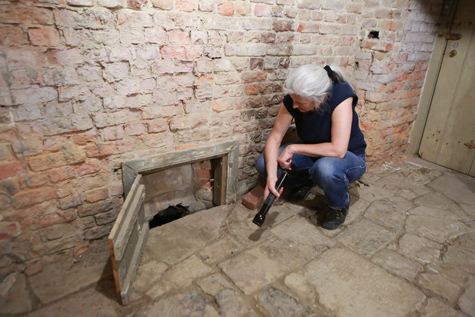By Caroline Watson, Lemon Project Anthropology Graduate Assistant
Those who are well-connected with the Lemon Project likely know Dr. Susan Kern. To meet Susan is to learn of her extensive knowledge of the inner and outer workings of William & Mary’s Historic Campus. Her knowledge base of campus history is rarely surpassed! This is unsurprising given Susan’s connection to William & Mary as an alumnus (Ph.D., History) and the university’s most recent Executive Director of Historic Campus (2014-2021). Susan took over as Executive Director of Historic Campus in 2014, replacing previous director Louise Kale, who took the honorable position in 1995 (and in whose name the daffodil garden in the North Wren Yard is dedicated).
As a key figure who has shaped the narrative surrounding Historic Campus, especially the Wren Building, I sought to learn more about Susan’s role as Executive Director. On a warm afternoon last October, we gathered for a coffee and a brief interview. My initial curiosities surrounded Susan’s job requirements, as not many universities have an institutionalized Historic Campus, much less an Executive Director of it. I was indeed surprised to learn of the breadth and diversity of roles that were required of such a position.

During her time at William & Mary, Susan facilitated and upheld working relationships with many local and state-wide institutions, including the Virginia Department of Historic Resources, the William & Mary Center for Archaeological Resources, the Muscarelle Museum, and facilities management. When she wasn’t occupied by the bureaucratic responsibilities that came with maintaining these relationships, Susan was tasked with managing Historic Campus’s resources. This management required not just a little bit of work and creativity from Susan; this was a colossal commitment on her part to care for the documents, artworks, and archaeological materials that belong to Historic Campus. A significant part of this care, we discussed, was focused on the archaeological resources. Susan herself was and is adequately prepared for such a task, given her experience working and directing Monticello’s archaeology department for 8 years. For those who may not know, W&M’s archaeological resources materialize in diverse forms. They range from technical reports, excavation descriptions and planning documents, publications, artifacts, and even the sites themselves. One of Susan’s most recent projects on Historic Campus oversaw the excavation of an 18th-century vaulted brick drain behind the Wren Building.
Historic Campus has been continuously occupied and used since the chartering of W&M in 1693—and long before that too. As such, Susan had her hands full writing, re-writing, and expanding the archaeological narrative of this landscape. In particular, Susan helped reframe thinking about campus as a site of slavery, including understanding the College (Wren) Building as William & Mary’s original slave quarter. Through her diligent work on Historic Campus and as a partner with the Lemon Project, Susan was committed to a more inclusive history at William & Mary.
Moreover, before leaving office, Susan composed a formal recommendation to Colonial Williamsburg and William & Mary regarding the best practices for the management of the University’s archaeological resources. As part of her plan, I continue to use the documents and resources that she gathered as part of my Lemon Project fellowship investigating the history of archaeology and slavery at W&M. Thank you again, Susan, for all your work!
